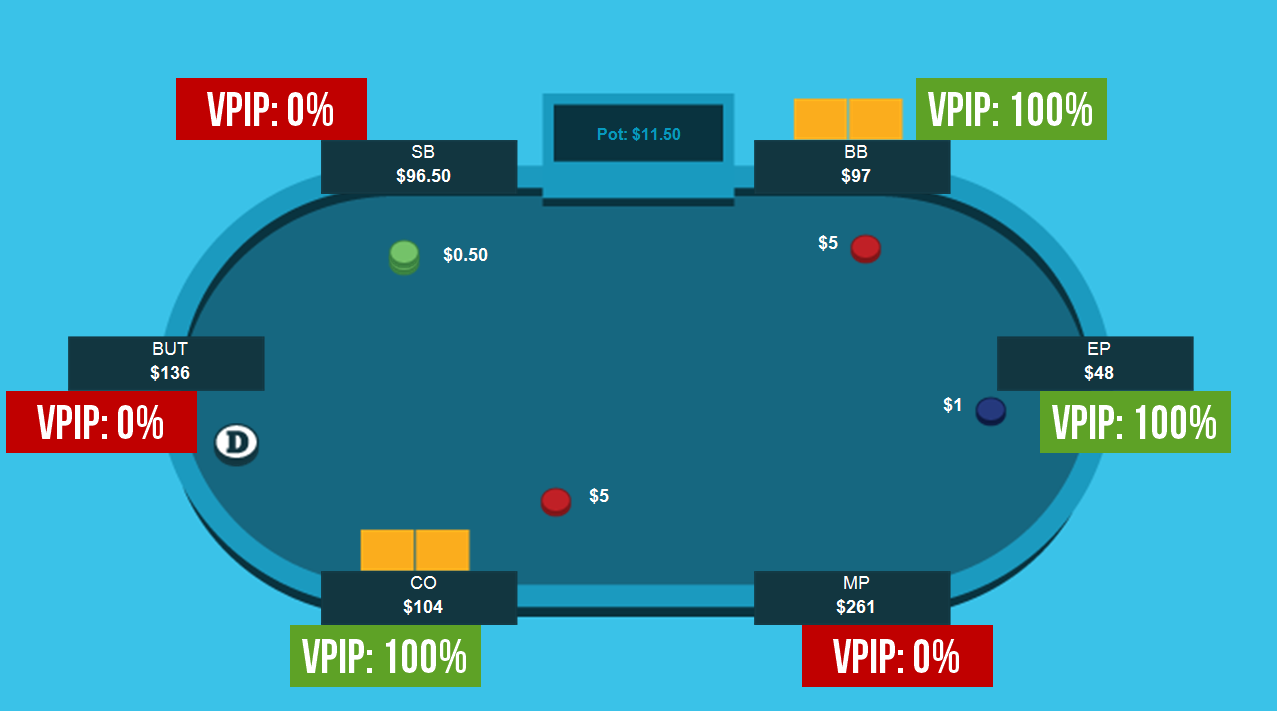A Poker VPIP Calculator is an essential tool for serious poker players looking to improve their game and gain an edge over their opponents. This powerful analytical instrument provides valuable insights into a player’s tendencies and playing style, helping to inform strategic decisions at the table. As the poker landscape continues to evolve, tools like the Calculator have become increasingly important for players seeking to stay competitive in both online and live games.
Poker VPIP Calculator
VPIP: 0%

A Poker VPIP Calculator is a specialized software tool designed to track and analyze a key poker statistic known as Voluntarily Put Money in Pot. This calculator typically integrates with poker tracking software or heads-up displays (HUDs) to provide real-time data on player behavior. The Calculator collects data on how often a player voluntarily puts money into the pot preflop, excluding blinds and antes. By analyzing this information over a large sample of hands, the calculator generates a percentage that serves as a crucial indicator of a player’s overall playing style and tendencies.
What Is VPIP
VPIP stands for “Voluntarily Put Money in Pot” and is one of the most fundamental and revealing statistics in poker analysis. This metric provides valuable insight into a player’s overall playing style and level of aggression. In poker, it represents the percentage of hands in which a player voluntarily puts money into the pot preflop, excluding blinds and antes. It’s calculated by dividing the number of times a player puts money in the pot voluntarily by the total number of hands played, then multiplying by 100 to get a percentage.
For example, if a player voluntarily puts money in the pot 20 times out of 100 hands played, their VPIP would be 20%. This statistic helps categorize players into broad style categories, such as very tight and conservative players with a low (less than 15%), solid and balanced players with a medium (15-25%), and loose and aggressive players with a high (greater than 25%).
What Does VPIP Mean in Poker
In the context of poker, VPIP is a powerful indicator of a player’s overall approach to the game. It reveals how often a player is willing to enter pots and commit chips, which can provide valuable insights into their playing style, risk tolerance, and potential hand ranges. A player with a low value is generally considered to be tight and selective, only playing premium hands. Conversely, a player with a high value is often seen as loose and more willing to play a wider range of hands.
Understanding this term can help players make more accurate reads on their opponents and adjust their strategies accordingly. For instance, when facing a player with a low VPIP, you might be more inclined to respect their bets and raises, as they are likely to have strong hands when they do enter a pot. On the other hand, when playing against a high VPIP opponent, you might look for more opportunities to bluff or value bet, as they are likely to be playing a wider and potentially weaker range of hands.

Why Does It Matter?
Understanding VPIP is crucial for several reasons in poker. Firstly, it allows for effective player profiling, quickly revealing whether an opponent plays tight or loose, which helps in adjusting your strategy accordingly. Secondly, tracking your own VPIP can highlight potential weaknesses in your game, such as playing too many hands or being too passive. This self-awareness is essential for continuous improvement and plugging leaks in your play.
VPIP data is also invaluable for table selection, helping you find profitable games by identifying tables with loose players who are more likely to make mistakes. In terms of hand reading, knowing an opponent’s VPIP aids in narrowing down their possible hand ranges, allowing for more accurate decision-making in crucial situations. Additionally, trends can indicate whether you’re playing within your bankroll by maintaining an appropriate level of selectivity, which is crucial for long-term success and sustainability in poker.
How VPIP Calculator Works
A VPIP Calculator operates by continuously monitoring and recording player actions during poker sessions. The calculator tracks every hand played, noting when players voluntarily put money in the pot preflop. It then divides the number of hands where money was voluntarily put in by the total hands played, converting this to a percentage. As more hands are played, the VPIP percentage is constantly recalculated to provide up-to-date information.

Why Poker VPIP Calculator Is Important
A Poker VPIP Calculator is a vital tool for players serious about improving their game for several reasons. It provides an unbiased, data-driven view of playing styles, removing emotional bias from self-assessment. This objective analysis is crucial for identifying and addressing weaknesses in one’s own game, as well as for understanding and exploiting opponents’ tendencies.
The calculator aids in opponent profiling, allowing players to quickly understand their adversaries’ tendencies and develop more effective counter-strategies. This information is particularly valuable in online poker, where physical tells are absent, and players must rely more heavily on statistical analysis to gain an edge.
From a bankroll management perspective, a PIP Calculator helps players maintain discipline by tracking their overall playing style and ensuring it aligns with proper bankroll management principles. It can alert players when they’re deviating from their optimal range, potentially playing too many hands and putting their bankroll at risk.
The tool also proves invaluable for game selection, assisting players in finding profitable tables by identifying opponents with exploitable tendencies. This can significantly impact a player’s win rate over time, as consistently playing against weaker opposition is a key factor in long-term poker success.
Furthermore, a Calculator enhances hand reading skills by providing context for an opponent’s likely hand range based on their VPIP. This improved ability to narrow down possible holdings leads to more accurate decision-making in critical situations.
Lastly, the calculator allows players to track their progress over time by monitoring changes in their VPIP across sessions. This long-term view helps players assess the effectiveness of strategy adjustments and ensure they’re moving in the right direction with their overall game plan.
How To Use Calculator
Using a VPIP Calculator effectively involves several steps and considerations.Data collection is a key aspect of using the calculator effectively. Players should aim to play a significant number of hands to ensure the VPIP data is statistically relevant, with at least 1000 hands per player generally considered necessary for meaningful results. As data accumulates, players must learn to interpret information in context, considering factors like game type, stakes, and player pool when analyzing VPIP percentages.
Applying data to inform decision-making during play is the ultimate goal. Players should adjust their strategy based on opponents’ VPIP tendencies, exploiting the tendencies of both tight and loose players. Regular self-analysis is also important, reviewing one’s own value to ensure play remains within optimal ranges for the chosen game type and stakes.
For a more comprehensive understanding, VPIP should be used in conjunction with other key stats like PFR (Preflop Raise) and AF (Aggression Factor). This multi-faceted approach provides a more complete picture of player tendencies and potential exploits. To further enhance your poker strategy, use our Omaha poker odds calculator for specific game insights and the poker calculator odds to evaluate potential outcomes in various scenarios.
FAQ
A “good” VPIP in poker depends on various factors, including game type, stakes, and playing style. However, some general guidelines can be helpful. In 6-max cash games, a range of 18-25% is often considered solid. For full ring cash games, this range typically drops to 14-20%. In tournament play, range of 15-22% is generally regarded as reasonable.
VPIP in poker stands for “Voluntarily Put Money in Pot.” It’s a statistic that measures the percentage of hands in which a player voluntarily puts money into the pot preflop, excluding blinds and antes. Its is a key indicator of a player’s overall playing style, revealing whether they tend to play tight or loose.
This statistic is crucial for understanding both your own tendencies and those of your opponents. A low value suggests a player is selective about the hands they play, while a high value indicates a player is more willing to get involved in pots with a wider range of hands. By analyzing VPIP, players can gain insights into their opponents’ strategies and adjust their own play accordingly.
Its calculated using a straightforward formula: the number of hands voluntarily played divided by the total number of hands, multiplied by 100 to get a percentage. For example, if a player voluntarily puts money in the pot in 30 hands out of 200 total hands played, their VPIP would be (30 / 200) x 100 = 15%.
While both VPIP and PFR (Preflop Raise) are important preflop statistics, they measure different aspects of a player’s style. VPIP measures overall voluntarily played hands, including both calls and raises, while PFR specifically measures the percentage of hands a player raises preflop.
PFR is always lower than or equal to VPIP, as all hands that are raised preflop are also voluntarily played, but not all voluntarily played hands are raised.




